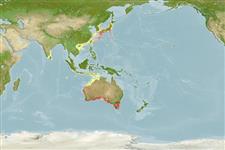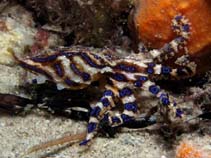Hapalochlaena maculosa (Hoyle, 1883)
Southern blue-ringed octopus| Native range | All suitable habitat | Point map | Year 2050 |

|
| This map was computer-generated and has not yet been reviewed. |
| Hapalochlaena maculosa AquaMaps Data sources: GBIF OBIS |
Classification / Names Common names | Synonyms | CoL | ITIS | WoRMS
Cephalopoda | Octopoda | Octopodidae | Octopodinae
Environment: milieu / climate zone / depth range / distribution range Ecology
Benthic; depth range 0 - 50 m (Ref. 96968). Tropical
Distribution Countries | FAO areas | Ecosystems | Occurrences | Introductions
Indo-West Pacific: Australia and Japan. Subtropical to temperate.
Length at first maturity / Size / Weight / Age
Maturity: Lm ? range ? - ? cm Max length : 22.0 cm TL male/unsexed; (Ref. 96968)
Mantle length is 5.7 cm. This species is extremely venomous, tetrodotoxin venom produced in the salivary glands has potential to cause human deaths (Ref. 96968). It lives on intertidal and shallow subtidal reefs, seagrass meadows, and rubble areas. It emerges at night and forages for small crustaceans and fishes. Hatchlings are benthic (Ref. 96968).
Life cycle and mating behavior Maturity | Reproduction | Spawning | Eggs | Fecundity | Larvae
Members of the class Cephalopoda are gonochoric. Male and female adults usually die shortly after spawning and brooding, respectively. Mating behavior: Males perform various displays to attract potential females for copulation. During copulation, male grasp the female and inserts the hectocotylus into the female's mantle cavity where fertilization usually occurs. Life cycle: Embryos hatch into planktonic stage and live for some time before they grow larger and take up a benthic existence as adults.
Main reference
References | Coordinator | Collaborators
Wood, J.B. and C.L. Day. 1998. (Ref. 3722)
IUCN Red List Status (Ref. 130435)
Least Concern (LC) ; Date assessed: 29 July 2014
CITES status (Ref. 108899)
Not Evaluated
CMS (Ref. 116361)
Not Evaluated
Threat to humans
Human uses
| FishSource |
Tools
More information
Age/Size
Growth
Length-weight
Length-length
Morphology
Larvae
Abundance
Growth
Length-weight
Length-length
Morphology
Larvae
Abundance
Internet sources
BHL | BOLD Systems | CISTI | DiscoverLife | FAO(Publication : search) | Fishipedia | GenBank (genome, nucleotide) | GloBI | Gomexsi | Google Books | Google Scholar | Google | PubMed | Tree of Life | Wikipedia (Go, Search) | Zoological Record
Estimates based on models
Preferred temperature
(Ref. 115969): 15 - 23.6, mean 18 (based on 144 cells).



